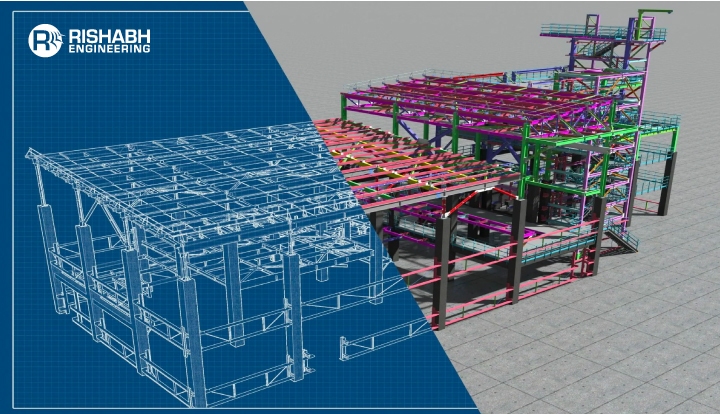
Importance Of Collaboration In Multidisciplinary Engineering Projects
In the rapidly evolving field of industrial engineering today, no discipline can function independently. Establishing a high value process plant facility or constructing a sustainable industrial plant all require close coordination between varied disciplines. And teamwork becomes not only beneficial but also necessary as projects become larger and more complex, thus blurring the distinctions between disciplines. Every phase of the project is certain to be more intelligent, secure, effective, and future proof with this type of integrated approach.
In this article, we will explore why collaboration in multidisciplinary engineering projects is essential for large scale industrial engineering projects and examine the best practices implemented by leading design engineering firms, like Rishabh Engineering.

What is Multidisciplinary Design Engineering?
Multidisciplinary design engineering refers to projects involving multiple engineering domains working collaboratively to develop a unified product or system. It combines knowledge from process, civil & structural, electrical & instrumentation, mechanical, piping, along with stress & analysis to support creation of industrial designs.
Why Multidisciplinary Engineering Collaboration Matters For Industrial Projects?
In multidisciplinary projects, coordination ensures that various engineering disciplines collaborate, which lowers design conflicts, delays, and cost overruns. It helps teams work together toward shared objectives, improves workflows, and promotes clear communication. Even the most sought-after ideas may not work without efficient coordination, endangering the overall success, safety, and efficiency of the project.
Here’s why collaboration is so vital:
- Risk Reduction: Well-coordinated teams minimize errors, design clashes, and compliance issues. It reduces rework, which in large-scale projects, can save millions.
- Resource Optimization: When every team knows their role and timeline, projects avoid costly delays and resource duplication.
- Innovation Enablement: Cross-discipline interactions often lead to breakthrough solutions that wouldn’t emerge in siloed environments.
- Improved Project Outcomes: Collaboration leads to better-quality products, services, and solutions that meet the needs and expectations of various stakeholders.
Common Coordination Challenges Encountered By Multidisciplinary Design Engineering Teams
Collaborating with engineers from other fields can provide difficulties. Every team may have its own priorities, tools, working methods, and technical jargon. This can lead to confusion, miscommunications, and delays, and in rare instances, costly design issues. In order to achieve timely, cost-effective, and high-quality results, these problems must be promptly fixed.
- Communication barriers: Each team may use different jargon and focus on different goals, which can lead to miscommunication and poor decision-making.
- Tool and system mismatches: Misaligned terminology and objectives: Teams may not speak the same “engineering language,” which can lead to misunderstandings and poor decisions.
- Isolated workflows: Teams that operate alone without cooperation may make decisions that inadvertently cause issues for other people.
Best Practices For Collaboration In Multidisciplinary Design Engineering Projects
Top design engineering businesses throughout the world use standardized procedures, advanced technologies, and structured communication to efficiently manage a wide variety of projects. These best practices guarantee adherence to international standards, improve team communication, and lower errors. Through innovation and cross-functional cooperation, these companies continuously provide scalable, effective, and superior technical solutions across a range of industries.
Listed below are a few.
- Centralized Project Management: By centralizing all tasks, due dates, and responsibilities, Autodesk Construction Cloud and other solutions assist teams in maintaining coordination.
- Shared Project Data: By ensuring that everyone is using the most recent updated models and drawings, platforms such as Trimble Connect help to minimize errors.
- Early Collaboration Across Teams: Engineering firms bring together a variety of expertise at the start of a project to make sure that everyone is on the same page from the start.
- 3D Coordination Tools (like BIM): Before building begins, teams can use Building Information Modeling (BIM) to see how everything fits together, preventing later, expensive conflicts.
- Regular Design Reviews: To exchange ideas, provide updates, and maintain focus, teams conduct check-ins at significant project milestones.
- Clear Global Communication Standards: Using common platforms like Slack or MS Teams and setting explicit rules for things like email and response times can help international teams work together more readily.
- Ongoing Training & Soft Skills: In addition to technical tools, top engineering firms regularly teach their staff in communication, teamwork, and leadership.
Measuring The Impact Of Multidisciplinary Engineering Collaboration
In multidisciplinary engineering, efficient coordination is not only a recommended practice; it can be measured. The true benefit of cooperation may be measured by enterprises by monitoring key performance indicators such as client happiness, design rework, cost savings, and project timeframes. The effectiveness of teams’ alignment, communication, and execution are demonstrated by these indicators, which ultimately emphasize the importance of collaboration for project success and ongoing development.
Metrics to Monitor
- On-time delivery vs planned milestones
- Reduction in rework
- Cross-discipline RFIs (Requests for Information) overtime
- Budget variance reports
Client Satisfaction & Stakeholder Buy-in
- Clear communication and visible progress boost client trust and reduce mid-project friction.
Rishabh’s Best Practices For Effective Collaboration In Multidisciplinary Engineering Projects
Rishabh Engineering prioritizes discipline-wide coordination to ensure excellent project results. Using cutting-edge engineering tools, globally recognized procedures, and proactive communication, the company often produces integrated design solutions. These best practices make Rishabh Engineering a reliable partner for intricate, multidisciplinary engineering projects worldwide by streamlining execution, reducing errors, and enhancing teamwork.
- Global Standard Operating Procedures (SOPs): They apply SOPs aligned with international codes across all engineering stages, ensuring consistency and clarity across disciplines and geographies.
- Centralized Tools and Technology Stack: Our engineers use at least two industry-standard tools per person—such as AVEVA E3D, Bentley AutoPLANT, CAESAR II, CADWorx, AutoCAD Plant 3D, STAADPro—to support multi‑discipline coordination and clash detection.
- Flexible Delivery & Engagement Models: They operate as a virtual extension of clients’ teams, offering off‑premise, on-site, or hybrid models depending on coordination needs. On‑site coordinators liaise between disciplines for smooth alignment.
- Frequent Interdisciplinary Checkpoints: Structured touchpoints—during FEED, detail design, and stress validation stages—allow team members to validate coordinated integrity and address clashes or overlaps in real time.
- Cross-Functional Expert Teams: 100,000 sq. ft. offshore development center enables cross‑functional teams to work under the same roof, facilitating daily coordination, shared learnings, and rapid feedback loops.
- Quality Assurance & Certifications: In line with ISO 9001, ISO 27001, and CMMI Level 3 standards, Rishabh Engineering team maintains rigorous quality governance frameworks that enforce coordination checkpoints throughout project execution.
Tools Supporting Coordination at Rishabh Engineering
- Common Data Environment (CDE): Ensures all users access up to date model/data versions.
- BIM & Piping Tools: AutoCAD Plant 3D, Bentley AutoPLANT, AVEVA E3D, PDS for clash detection.
- Stress Analysis Software: CAESAR II, STAADPro for validating multidisciplinary interfaces.
- Communication & Hosting Tools: MPLS network, real time backups, video conferencing, hybrid tool infrastructure
Final Thoughts
The success of multidisciplinary design engineering services depends on effective cooperation. It unites experts from several disciplines into a cohesive, productive team. Collaboration is what turns concepts into tangible outcomes, whether it is via the use of contemporary tools like BIM or just effective communication. The method we collaborate will change as engineering continues to advance, but effective coordination will always be crucial.
Frequently Asked Questions
Q. Why is coordination vital in multidisciplinary engineering projects?
A. Because it prevents design clashes, reduces errors, and ensures timely and cost-effective project completion.
Q. What is the role of BIM in project coordination?
A. BIM acts as a centralized model that allows different disciplines to view, modify, and test their designs in real-time, ensuring compatibility.
Q. How do global companies manage time zone differences?
A. They use cloud tools and set universal protocols for updates, reporting, and deadlines to keep everyone aligned.
Q. Can coordination reduce project costs?
A. Yes, by minimizing rework, avoiding delays, and optimizing resource usage.
Q. Are digital twins replacing BIM?
A. Not replacing but enhancing. Digital twins build on BIM by offering real-time simulation and feedback loops during the operation phase.
Seek Help with Multi-Disciplinary Collaboration?
Explore the best practices from experienced design engineering companies like Rishabh Engineering to see how collaboration reduces risks and ensures project success.
Related Blogs
Related Blogs
Best Structural Engineering Software for Accurate Analysis
Finding tools that simplify and improve the accuracy of the…
Detailed Engineering Considerations for Project Success
Engineering projects today require meticulous planning and execution across various…


